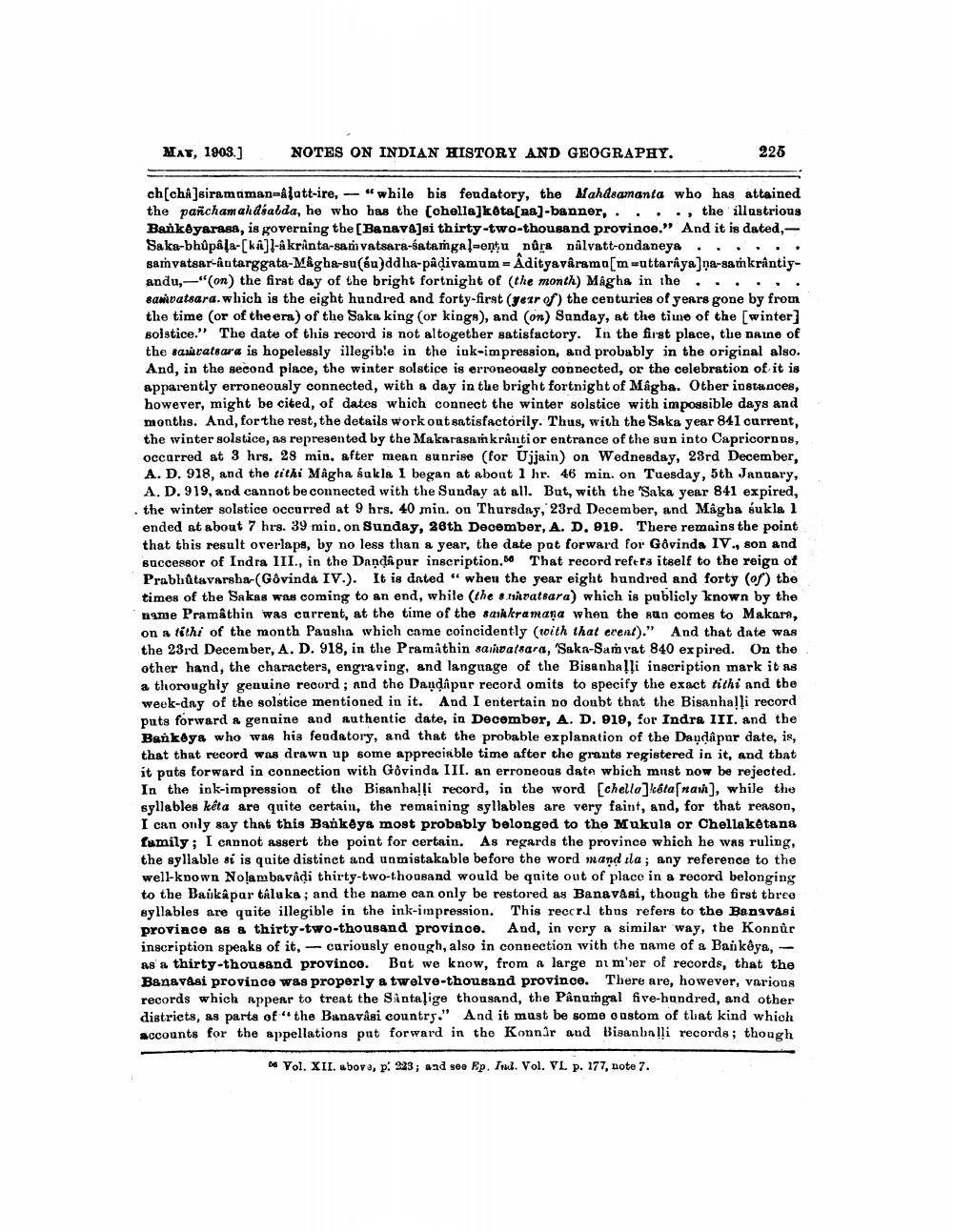________________
MAX, 1903.]
NOTES ON INDIAN HISTORY AND GEOGRAPHY.
225
ch[châ]siramaman-Alatt-ire, "while his feudatory, the Mahdsamanta who has attained the panchamahdsabda, he who has the [chella]kêta[na]-banner,.... the illustrious
8
Bankêyarasa, is governing the [Banava]si thirty-two-thousand province." And it is dated,Saka-bhûpâla-[k]]-âkranta-samvatsara-sataṁgal-entu nûra nâlvatt-ondaneya samvatsar-ntarggata-Magha-en(n)ddha-pāḍīvamum Âdityaviramo[muuttaraya]pa-samkrintiyandu,-"(on) the first day of the bright fortnight of (the month) Magha in the . samvatsara.which is the eight hundred and forty-first (year of) the centuries of years gone by from the time (or of the era) of the Saka king (or kings), and (on) Sunday, at the time of the [winter] solstice." The date of this record is not altogether satisfactory. In the first place, the name of the samvatsara is hopelessly illegible in the ink-impression, and probably in the original also. And, in the second place, the winter solstice is erroneously connected, or the celebration of it is apparently erroneously connected, with a day in the bright fortnight of Mâgha. Other instances, however, might be cited, of dates which connect the winter solstice with impossible days and months. And, for the rest, the details work out satisfactorily. Thus, with the Saka year 841 current, the winter solstice, as represented by the Makarasainkranti or entrance of the sun into Capricornus, occurred at 3 hrs. 28 min. after mean sunrise (for Ujjain) on Wednesday, 23rd December, A. D. 918, and the tithi Mâgha sukla 1 began at about 1 hr. 46 min. on Tuesday, 5th January, A. D. 919, and cannot be connected with the Sunday at all. But, with the 'Saka year 841 expired, the winter solstice occurred at 9 hrs. 40 min. on Thursday, 23rd December, and Magha sukla 1 ended at about 7 hrs. 39 min. on Sunday, 26th December, A. D. 919. There remains the point that this result overlaps, by no less than a year, the date put forward for Govinda IV., son and successor of Indra III., in the Dandapur inscription. That record refers itself to the reign of Prabhutavarsha-(Govinda IV.). It is dated "when the year eight hundred and forty (of) the times of the Sakas was coming to an end, while (the snavatsara) which is publicly known by the name Pramâthin was current, at the time of the sankramana when the sun comes to Makara, on a tithi of the month Pausha which came coincidently (with that event)." And that date was the 23rd December, A. D. 918, in the Pramathin samvatsara, Saka-Samvat 840 expired. On the other hand, the characters, engraving, and language of the Bisanhalli inscription mark it as a thoroughly genuine record; and the Dandapur record omits to specify the exact tithi and the week-day of the solstice mentioned in it. And I entertain no doubt that the Bisanhalli record puts forward a genuine and authentic date, in December, A. D. 919, for Indra III. and the Bankeya who was his feudatory, and that the probable explanation of the Dandapur date, is, that that record was drawn up some appreciable time after the grants registered in it, and that it puts forward in connection with Govinda III. an erroneous date which must now be rejected. In the ink-impression of the Bisanhalli record, in the word [chella]kéta [nam], while the syllables kéta are quite certain, the remaining syllables are very faint, and, for that reason, I can only say that this Bankêya most probably belonged to the Mukula or Chellakêtana family; I cannot assert the point for certain. As regards the province which he was ruling, the syllable sí is quite distinct and unmistakable before the word mand ila; any reference to the well-known Nolambavadi thirty-two-thousand would be quite out of place in a record belonging to the Bankapur taluka; and the name can only be restored as Banavasi, though the first three syllables are quite illegible in the ink-impression. This reccrd thus refers to the Banavasi province as a thirty-two-thousand province. And, in very a similar way, the Konnûr inscription speaks of it, cariously enough, also in connection with the name of a Bankêya, - as a thirty-thousand province. But we know, from a large ni m'er of records, that the Banavasi province was properly a twelve-thousand province. There are, however, various records which appear to treat the Santalige thousand, the Pânumgal five-hundred, and other districts, as parts of " the Banavâsi country." And it must be some custom of that kind which accounts for the appellations put forward in the Konnâr and Bisanhalli records; though
6 Vol. XII. above, p. 223; and see Ep. Ind. Vol. VI. p. 177, note 7.
-




